Hamster Accessories and SuppliesGet Advice before BuyingHamster Ball BasicsHamster WheelTubes and TunnelsHamster HousesFood DishesWater BottlesHamster ToiletSand BathWhen you provide your hamster with some basic cage accessories, you will dramatically improve your pet’s quality of life. With a range of activities to choose from, these items will ensure your hamsters get plenty of exercise and importantly, fight off boredom. Additionally, there are certain items that will make them more comfortable while inside their hamster cages. In short, an entertained and comfortable hamster is a healthy one – and one that is less likely to come down with an illness.The following is a list of items to consider purchasing but read our advice and tips before you pick any accessories up at your local pet store.
Exercise Ball Basic
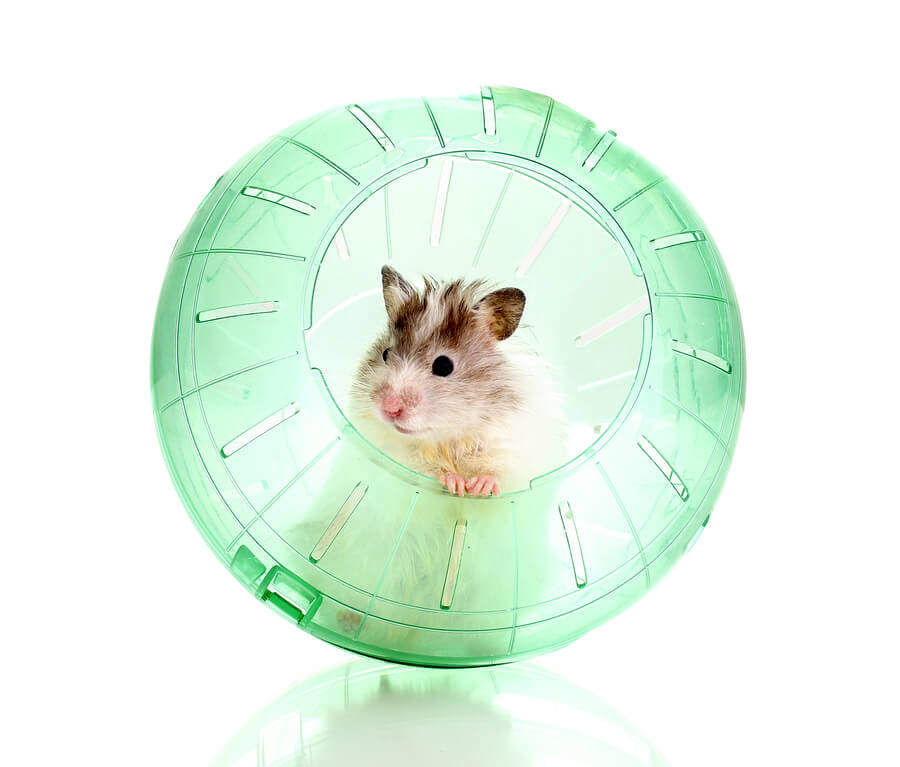
A hamster ball is one of the many accessories that is intended to provide your hamsters with exercise options. Today there are several variations of this accessory. There are of course the free rolling balls that you probably already have an idea about but there are also balls that run on tracks, ones that are stationary, novelty ones look like cars and even hamster balls that can be attached to your hamster habitat. Exercise balls are a great alternative to the wheel but they come with additional rules and precautions.
The Ground Rules
- Limit your hamster to no more than 10-15min per exercise session
- Always supervise your hamster while it is in its ball; Especially the free rolling balls
- Hamster proof your exercise area to avoid falls and attacks from other pets
- Never push or kick it; this can lead to serious injury and fear of the ball
- If you have small children, avoid novelty options that resemble their play toys
when you put a hamster in its ball, it’s different than when it’s on its wheel. When your pet hamster gets tired on it’s wheel it can get off and go rehydrate by taking a drink of water from its water bottle. In a exercise ball, your pet won’t be able to stop for a water break which can lead to dehydration. For this reason your little guy’s exercise session should be a maximum of 15min.It’s important to supervise your hamster while it’s in a ball for several reasons. The first reason is to avoid exhaustion and dehydration which was just explained. The second reason is so your hamster doesn’t hurt itself by falling off a set of stairs or it gets used as a play toy by your dog or cat. Hamster proofing your house will help limit these threats but that doesn’t mean your little pet doesn’t need to be supervised. Hamster balls can pop open if it builds up some speed and hits an object head on. If you are there to see this happen, you will be able to catch the runaway hamster. Finally if your play area is a carpeted area, you will need to watch for signs that your hamster is nibbling on any carpet pieces that might be sticking through the air vents on the plastic ball. Carpet probably isn’t good for the digestive tract.
Select an Exercise Ball
Select one that has a large enough diameter so your hamster isn’t force to bend its back upwards. For the same reason why you need a hamster wheel with a large enough diameter, a hamster that has to constantly bend upwards can damage its spine and cripple it. In addition to size, if the ball is too small, your little pet will likely not get enough oxygen which can lead to suffocation.Your baby Syrian will eventually grow into an adult and need a hamster ball larger than what you provided it as a baby. Likewise, if the diameter is too big for a baby or dwarf breed, it can lead to them being thrown around and could potentially cause injury.
Introduce your hamster to its new exercise equipment slowly and don’t force it if it isn’t ready; just like you should with all of your new accessories. Some take to it right away, while others might be hesitant and need additional time to get used to it. In the beginning, keep the play sessions short and eventually over time, increase the duration. With some time and practice, your hamster can become a pro at maneuvering the ball to where it wants to go. When or if this happens, you can try creating mazes or courses for it to tackle during its workout.
Exercise Wheels
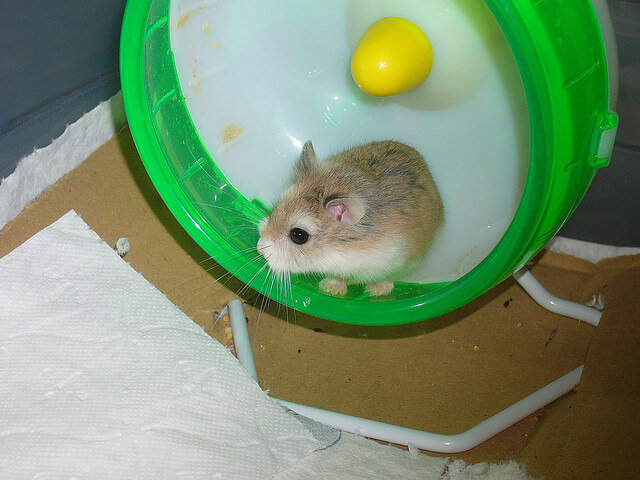
When it comes to buying hamster accessories, a hamster wheel is another must have. In the wild, hamsters are known to run several miles a night and no cage, no matter how large, could ever give your pet hamsters that luxury. This lack of space can be made right by adding a hamster wheel. Hamsters naturally take to these wheels and don’t require any training. A hamster wheel allows your pet to get the exercise it needs to stay fit and also relieve stress. Low stress equates to a hamster more willing to allow being handled. Studies show that if a hamster is constantly on its wheel, its hamster cage size is too small; however, studies also show that even after a hamster is moved from a small cage to a large one, they still use their hamster wheel.
Select the Right One
Often times when you purchase a hamster cage from a pet store, it will come with a hamster wheel. This doesn’t mean it’s the right wheel for your hamster though. In fact, they might be too small in diameter or contain metal rungs; both of which can cause injury to your little pet. If you choose to keep that metal rung wheel, you can weave cardboard between the rungs so your hamster’s feet don’t fall through. Additionally these cheap wheels can be rather noisy but might be fixed by adding a few drops of vegetable oil to the problem areas. Your wheel should have a flat running surface, a diameter proportionate to your hamster, enclosed on one side and it turns easily.
Hamster Injuries
- Avoid foot injuries by selecting a wheel with a continuous solid running surface and not one with metal rungs.
- Spine and back injuries can occur when a wheel diameter is too small and your hamster’s back is bent upwards.
- If your hamster loves to gnaw plastic, avoid digestion problems by choosing a wheel made out of sheet metal.
- Avoid fights and biting between hamsters by adding additional wheels to accommodate the need to run.
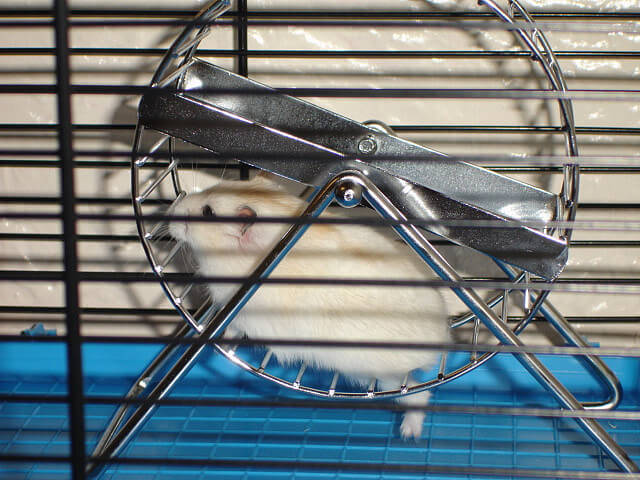
The Need for Tubes and Tunnels
Hamster tubes and tunnels are hamster accessories that are strongly recommended for several reasons. The first reason is that these tubes can increase the square footage of any hamster cage but this is especially important for small cages. In the wild a hamster can roam around a few miles a night so the larger the habitat you can provide, the happier your hamsters will be. The second reason is that when you setup hamster tubes and interconnect them between modules or create an elaborate hamster maze, you are recreating the hamster’s natural habitat. Since a hamster spends the majority of its life underground in its tunnels and burrows. Lastly, by adding hamster tubes and tunnels and rearranging them every so often, you are providing a constant change of scenery that will keep your hamsters thinking. Boredom can often lead to unhealthy behaviors so add tubes, tunnels, toys and other accessories to keep your hamsters healthy.
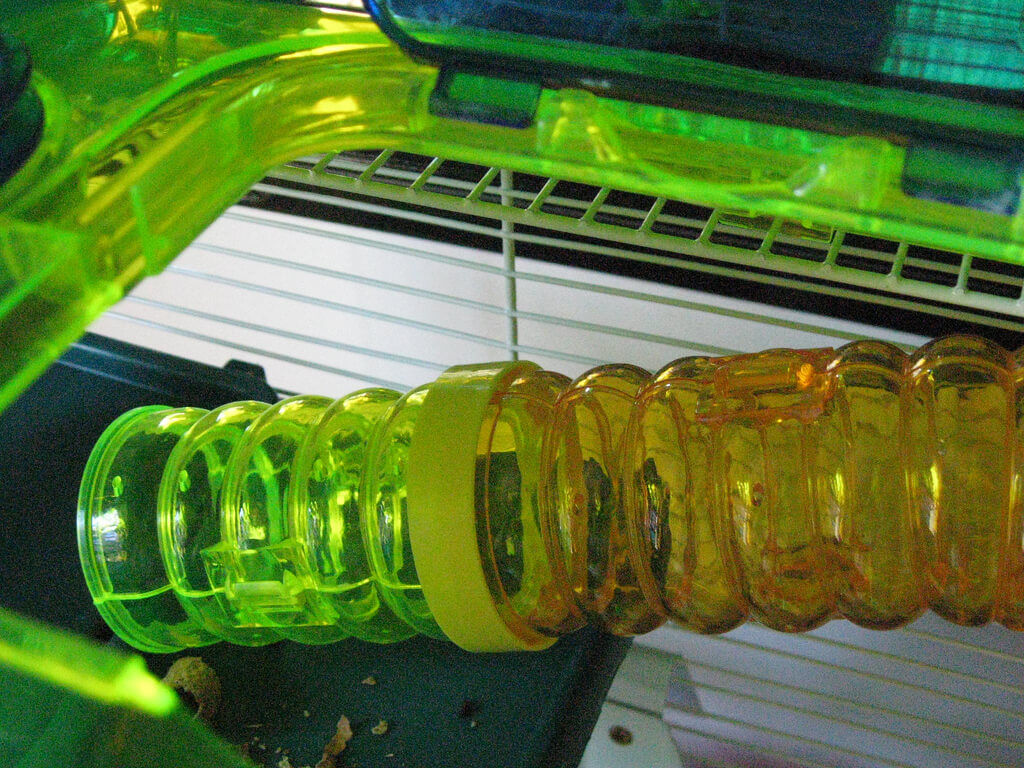
Tips and Advice
When purchasing your hamster tube add-ons you need to know that not all brands work together. What ever brand or hamster habitat you have, you should stick to purchasing that brand of hamster tube. If the tubes don’t fit securely together, a hamster can find a way to gnaw or force its way through the defects of its setup. Sometimes you might need to secure mixed matched tubes using tape but avoid this and stick to one brand.
You should select all of your add-ons and accessories based on your hamster breeds. If you own a dwarf or Chinese hamster, you need to buy smaller sized versions of tubes to make them usable by these small breed of hamster. Even with the appropriate size tubes, a small hamster might have difficulty climbing vertically aligned tubes. If this occurs you can add a ladder inside the tube or setup the tubes in a more horizontal alignment.
Routine Maintenance
The more tubes you have the more maintenance that is required. By having an extensive hamster habitat, you will ensure a healthy hamster but that comes with more responsibility in the way of cleaning. When it comes time to clean a hamster cage, you will first need to remove your hamsters from their cage and place them into a temporary cage. This could be a challenge in its own if your hamsters bolt for a tube when they see your hands enter their cage but once you get your hamsters into the temporary cage, you will need to take the tube system apart and clean their insides by removing any waste or debris.Use hot water and a diluted soapy mixture to scrub the insides with a scrubber on a long handle; a water bottle brush is a good solution. After you have done a sufficient job, rinse the hamster tubes thoroughly. It’s important to note that you should never use bleach or harsh detergents in the cleaning process because any left over residue can create toxic odors inside these confined spaces.Recommended Tubes
Feeding Dishes
A food dish is one of those hamster accessories that every pet hamster owner gets but later wonders why they even bothered. You will probably think the same thing once you see your little guy carrying off its food in its check pouches only to bury it in a corner. If it’s not that, it might decide to take it into its sleeping house for safe keeping or midnight snack. This type of behavior is perfectly normal and you shouldn’t be concerned when you observe it.With all that said, it’s still a good idea to get a dish so your hamsters know exactly where they can go to get fresh food. It’s also a good place to put any live food like meal worms or grubs you might want to feed to your hamster.
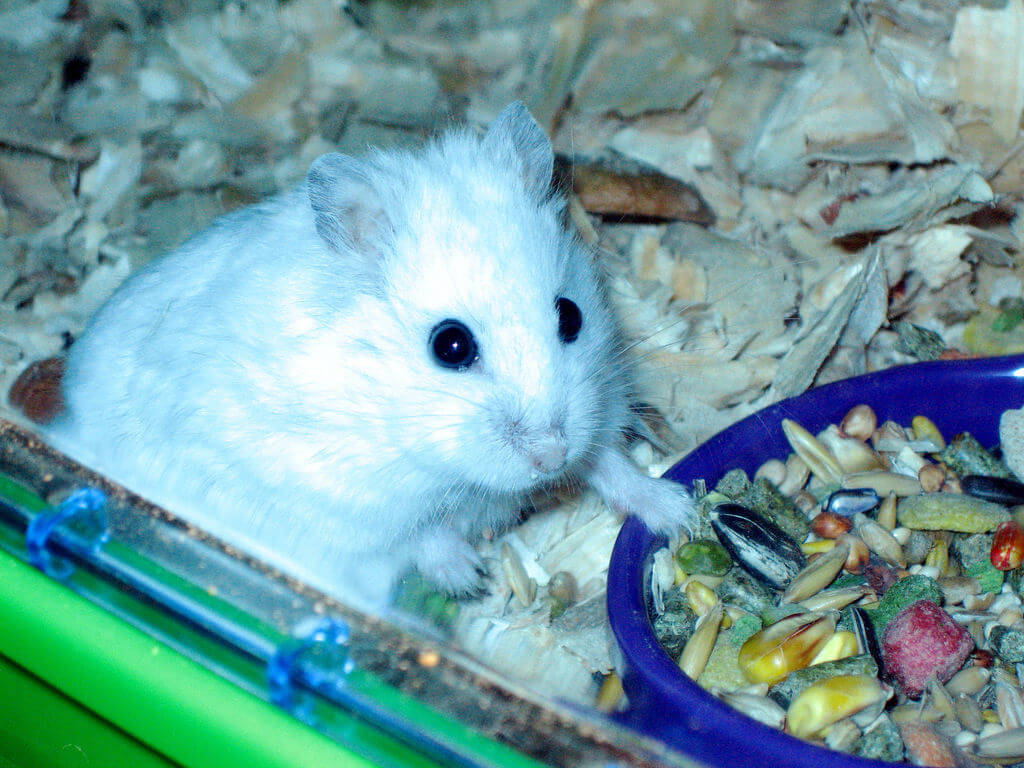
Find a place for hamster’s “kitchen” in area that is away from the bathroom area and sleeping quarters. You should fill it and clean it daily to reduce any germs from building up, which in turn, can lead to an illness. Next, don’t put your little pet’s drinking water in a food dish though, opt for a hamster water bottle instead.A feeding dish should be at least 2.5 inches tall (6cm) with a rim to keep any food from falling out. It should be made out of porcelain or stoneware because these materials are gnaw proof and also heavy enough so your hamster can’t easily knock it over. For added stability, many dishes can be secured to the wire bars of a hamster cage or plastic habitat.
About Water Bottles
Like all living things, hamsters need plenty of fresh water to survive. The best way to provide your pet hamsters with a source of fresh water is by adding water bottles to their hamster cages. These hamster accessories are a must have for many reasons.
Bottle vs. Dish
For starters, the alternative to a water bottle is a hamster food dish. If you choose to us a dish as a water source, you will quickly see is get polluted with food, bedding and animal waste. It becomes nearly impossible to keep up on the maintenance. On top of that, hamsters have been known to drowned in their water dishes.
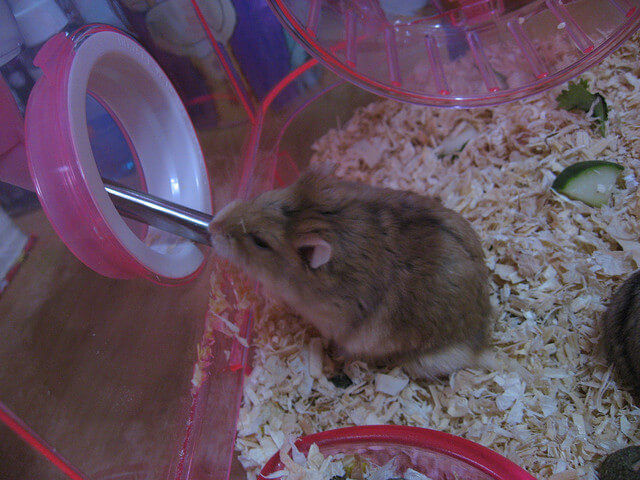
Water bottles on the other hand will ensure that no foreign materials get mixed in with your hamster’s drinking water. When you buy a double ball bearing sipper bottle, you can fill it full of water and when you invert it the water should stay in the bottle. When a hamster wants to take a drink, it simply pushes on the end of the ball bearing and water is then slowly released. “Should” is the keyword here; test a water bottle before you buy it. If it leaks, don’t buy it.
Tips for Installing One
A water bottle can be attached using a special wire hanger to wire cages or suction cups onto aquariums or plastic habitats. If possible, it’s best to place the water bottle on the outside of the cage since most bottles are made out of plastic and your hamster will likely want to gnaw on it. If it isn’t possible, make sure the plastic edges are rounded or you have a metal shield so your hamster can get its teeth into it (You can also try a chew proof water bottle guard). Make sure the placement of the bottle is set to a level that allows all your hamster to get at it.
Importance of a Sleeping House
A hamster house is one of the must have hamster accessories for any type of cage. Consider it home base or a happy place for your pet hamsters since they are likely to seek it out whenever they want to curl up to take a nap or hide inside whenever they get nervous by. Chances are they will even bring snacks inside their bed for safe keeping or an afternoon snack (the equivalent of our midnight snack).
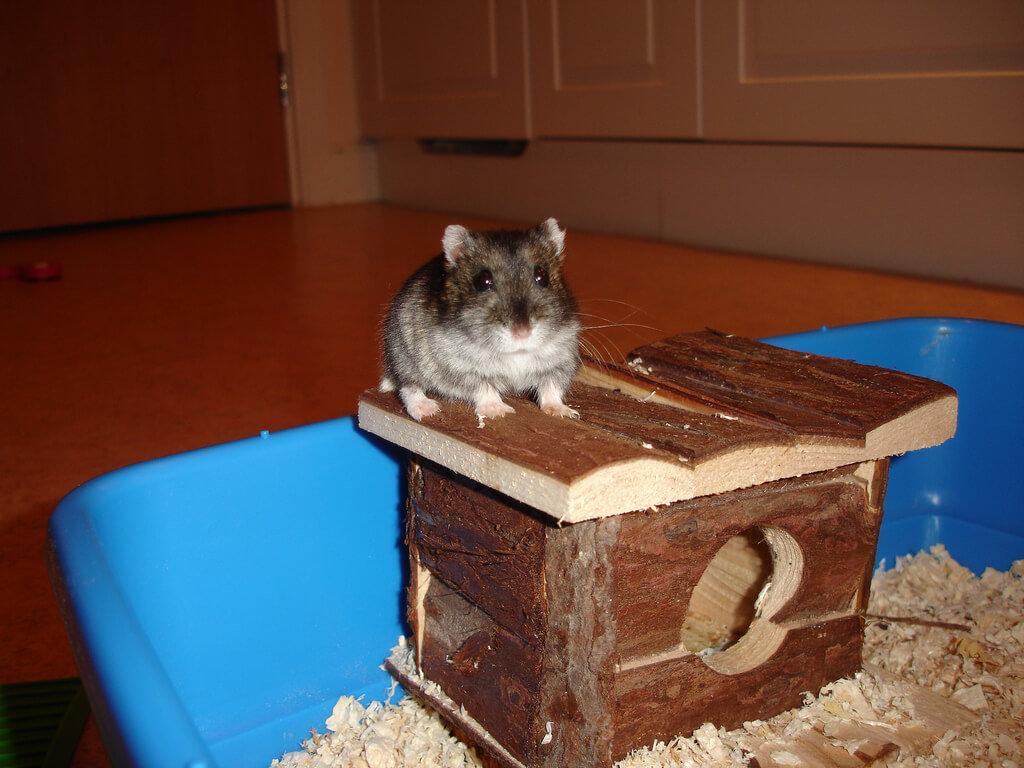
What to look for
Placing a hamster house inside your pet’s habitat is a great way to recreate the hamster’s natural habitat of an underground burrow or nest. Keep this in mind when selecting your house. The best option is small houses with one round entrance hole; or possibly two. This really gives your pet hamster piece of mind as it will feel safe while tucked away inside.
The inside of the house should not be too large and also not be too small. The recommended dimensions suitable for a Golden Syrian hamster is roughly 4″ x 8″ (20 x 10cm) with the entrance hole being an 1″ and 3/4. For a dwarf hamster the dimensions can be slightly smaller at around 3″ x 6″ ( 7.5 x 15 cm) with the entrance hole of the hamster house being 1.5″ inches (3.5cm).Other things to look for when selecting a hamster house: It is best to have one that is gnaw proof. Doing so will ensure your hamsters don’t destroy it or end up sick from trying to digest tiny bits of plastic. A removable roof is convenient when it comes time to cleaning and lastly a flat roof allows for more spaces to climb up onto.
Get a Toilet Potty Box
Hamster by nature are clean animals and will often designate an area of their living space for doing their business. Typically the bathroom toilet is in a corner or space away from their main living space, hamster house or feeding area. A hamster will occasional have an accident in other areas of its cage or on some of its hamster accessories but the majority of its bathroom breaks will be done in its designated hamster toilet.
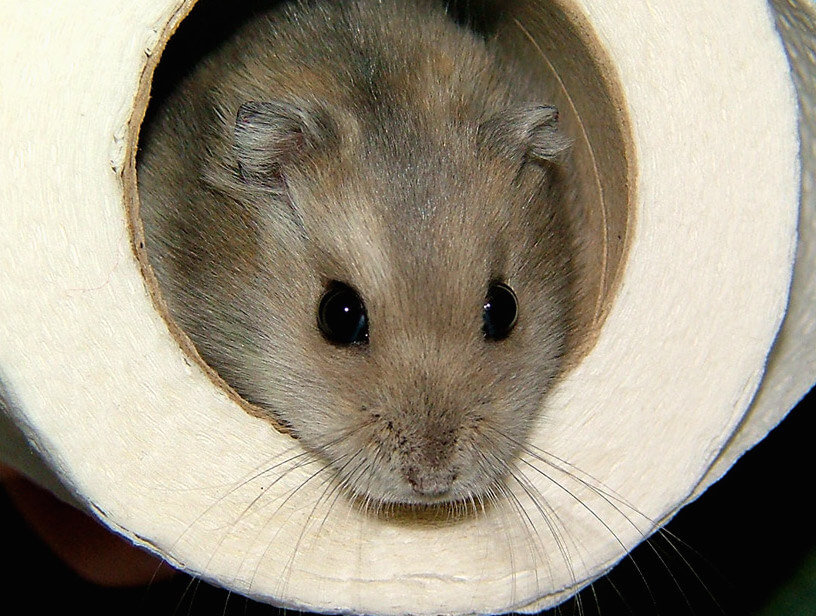
What are the Benefits of Getting One?
There is a benefit to placing a hamster toilet potty into your hamster cage. As you might think, urine and waste can create an unpleasant odor, requiring you to change your hamster bedding once a week and in hamster cages with multiple hamsters, more often than that. In addition to the smell, the break down of urine creates ammonia. When ammonia levels build up in an enclosed hamster habitat, it can become toxic and lead to respiratory problems in any hamsters that are exposed to these conditions. By adding a hamster toilet, you can easily remove it to clean and not have to change the bedding as often.
How to Potty Train a Hamster
- Determine where your hamster’s bathroom area(s) are located.
- Place the hamster toilet in the area they have chosen as their bathroom.
- Add some absorbent litter into the bottom of the bathroom.
- Add a bit of soiled bedding into the bathroom to encourage the hamsters to use it.
Selecting a Bathroom
You can either buy a hamster toilet from a pet store or make a homemade one. Store bought ones often come with a scoop and a bag of litter but are made out of plastic that can be gnawed on. You can use a glass mason jar that is very inexpensive and gnaw proof. Either way you decide to go, there are a few options you can chose from. Most of the options include a covered box similar to a cat litter box but on a smaller scale for obvious reasons. The opening should be 2-3 inches in diameter and 1 inch from the base. This will allow enough room for your hamsters to get in and out with out tracking any litter out.
Litter Options
Hamster litter can be bought at a pet store and comes in several different type of mixtures. If hamster litter is not available you can buy a dust free, scent free, clumping cat litter that doesn’t contain silica dust. You can try a variety of pet litters or absorbent wood, paper, or grain pellets to see what your hamster prefers. Bedding can of course be used but if it is used in a hamster toilet, it will have to be changed daily since it will likely stay wet in the confined space.
The best way to do this is by observing your hamsters’ behavior. Furthermore, if you observe your hamster pouching the litter, you should consider trying another variety. Even if its non toxic, your hamsters shouldn’t be eating its litter.
What’s a Sand Bath?
Normally a hamster will clean itself like a cat does but on occasion it will roll around in a hamster sand bath. A hamster sand bath consists of shallow dish or pan full or sand that a hamster will roll around in to clean itself from any possible parasites it might have in its fur. This an activity that’s typically a big hit among dwarf hamsters but not as much the larger breeds like the Syrian.If you add this accessory, you should be sure to buy chinchilla sand that doesn’t contain dust that can lead to respiratory problem in your hamster. You should avoid beach sand because it contains pathogens that can make your hamster sick. However, if you do choose to use this type of sand, you can place it in the oven and cook it a 350*f (176*c) for about an hour to kill anything that will make your pet hamster sick.After you place your hamster sand bath into your cage, let your hamsters feel it out for awhile and don’t force them into the bath. if they like they will bathe in it and if they don’t, they won’t. Like many accessories you add, they may not use it for its intended purpose; they might use as the bath as a bed or even use it as a place to hide their food.
Should You Give a Hamster a Bath?
You should only give your hamster a bath in rare situations where there is clear and present danger to the health of your hamster. If your hamster is covered in a toxic chemical that has the potential harm its skin or negatively affect its body systems, then it is okay to gently wash your hamster with lukewarm water and pet or baby shampoo. Be as careful as you can not to get water in the eyes, ears or mouth of your hamster since it could severely stress it out and doing so, it will struggle to flee which could lead to serious injury. If this toxic material can be cutout of the fur, then that should be your first solution. Using water should always be a last resort.When purchasing items for you pets, you should always find out it the product in question is safe for them. Some inferior quality products might not be made out the best materials. It’s a good idea to read reviews and see what the community says first before buying anything. Furthermore, if you want to use everyday items to place into your hamster’s cage, make sure the materials are nontoxic and don’t have sharp corners that could cut them.
photos: necrocake, bsabarnowl, cdrussorusso, fuzzcat, keren, jpockele
Reviewed By: Tim Winter

Tim Winter has a strong affection for pets and wildlife. His years of experience caring for various types of pets has led him to share his knowledge with others on the best practices in pet care. Tim holds a Bachelor of Science from the University of Oregon School of Journalism and Communications.

you can add a sand bath as in reptile sand or other safe sand in a dish the hamster will enjoy bathing in that .NEVER bath a hamster in water .
When you first get a hamster, how long should it be until you should be able to pull class it up?
Can I put sand sheet at the bottom of my hamster cage like in a bird’s cage
If you mean sand paper that is used to sand wood, no. That’s tough hard on a hamster’s little feet.
If I put the sand bath in my hamsters cage and then I put a litter box in the corner where he goes to the bathroom, will he use the sand bath as a sand bath if it isnt in the corner where he goes to the bathroom?????????????
Is it ok to put the bathing sand on the floor since they pee alot which coz bad smell. But i am scare it can cause respiratory problem.
if the hamster cage should have tight “wires” to prevent the hamster from escaping, how do i setup the hamster tubes if the tubes should be big enough for the hamster to get in?
Your hamster cage should have a area to connect the tubes to it. If not, then you should not use the tubes until you get the right cage for it.
If the hamster tube must be big enough for the hamster to get in, then how do i setup the hamster tube on my hamster’s cage if the bars on the cage should be tight enough to prevent the hamster from escaping?
I’m not entirely sure what you mean? Usually, to add tubes, you need to have a hamster cage that was designed to allow them to be added. If you use an standard cage, you might not be able to add tubes. There are some attachments you can put on a cage door opening called an adapter or coupler that you might consider.